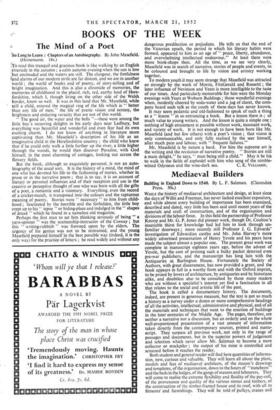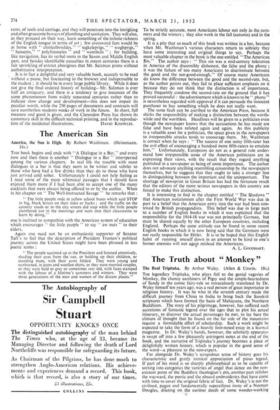Mediaeval Builders
Building in England Down to 1540. By L. F. Salzman. (Clarendon Press. 50s.) Wilms the history of mediaeval architecture and design, at least since the days of Willis and Freeman, has never lacked excellent expositors, and while almost every building of importance has been examined, described and dated, very little has been said until recent years of the materials and craft of construction, and of the organisation and divisions of the laboul- force. In this field the partnership of Professor Knoop and Mr. G. P. Jones did pioneer work, though Dr. Coulton's insatiable thirst for knowledge had led him to look through un- familiar doorways ; more recently still Professor J. G. Edwards' investigation of Edwardian castles and Mr. John Harvey's more widely advertised presentation of Henry Yevele and his peers have made the subject almost a popular one. The present great work was complete in manuscript eighteen years ago, before the advent of Yevele, but the cost of printing such a bulky packet deterred even pre-war publishers, and the manuscript has long lain with the Antiquaries at Burlington House. Fortunately the Society of Authors, with great discernment, has now provided a grant, and the book appears in full in a worthy form and with the Oxford imprint, to be prized by lovers of architecture, by antiquaries and by historians alike, and doubtless also to be- consulted by those many readers who are without a specialist's interest yet find a fascination in all that relates to the social and artistic life of the past.
The book is called a documentary history. The documents, indeed, are present in generous measure, but the text is not so much a history as a survey under a dozen or more comprehensive headings of all the activities, intellectual, administrative and physical, and of all the materials and techniques that went to the erection of buildings in the later centuries of the Middle Age. The pages, therefore, are neither a narrative nor a discussion, but an orderly and on the whole well-proportioned presentation of a vast amount of information taken directly from the contemporary sources, printed and manu- script. They surpass all previous work, not only in the range of passages and documents, but in the superior powers of judgement and selection which never allow Mr. Salzman to become a mere collector or stockpiler ; the output of his mine is controlled and screened before it reaches the reader.
Both student and general reader will find here quantities of informa- tion, new, curious and valuable. They will learn all about the plans, models and fees of mediaeval architects, of the mason's drawings and templates, of the organisation, down to the hours of "nuncheon" and the beds in the lodges, of the gangs of masons and labourers. They will come to realise the extreme flexibility and fluidity of the pay-roll, of the provenance and quality of the various stones and timbers, of the construction of the timber-framed house and its roof, with all its fitments' and furnishings. They will be told of pulleys; cranes and
rams, of tools and carriage, and they will penetrate into the intriguing and often gruesome byways of plumbing and sanitation. They will also, as they proceed on their way, learn something of the infinite richness of the English tongue in terms of art ; few crossword fans would be at home with " chinkelbroddes," " tegkeleprigs," " woghprigs," " hussems," " polyftrenseles " and " wombells " ; • for building, like navigation, has its verbal roots in the Saxon and Middle English past, and besides identifiable casualties in retent centuries there is a fair sprinkling of extinct aborigines that Mr. Salzman prints without authoritative interpretation.
It is in fact a delightful and very valuable book, scarcely to be read without a pause, but fascinating to the browser and indispensable to the student ; it should be in every large public library. While it does not give the final ordered history of building—Mr. Salzman is ever half an antiquary, and there is a tendency to give instances of the same phenomenon from widely separated centuries rather than to indicate slow change and development—this does not impair its peculiar worth, while the 250 pages of documents and contracts will save numberless students weeks of work in the future. In short, full measure and good is given, and the Clarendon Press has shown its customary skill in the difficult technical printing, and in the reproduc-



































 Previous page
Previous page